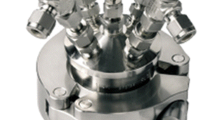Abstract
Modern membrane technologies are useful for enhancing the concentration of phenolic antioxidants in olive mill waste water (OMWW) to produce concentrates with valuable applications in functional foods. Three types of OMWW concentrates, each with different levels of solute concentration and purity, were obtained from a single OMWW batch and dissolved in two extra virgin olive oils to achieve saturated solutions. Three addition levels were considered. Accelerated aging testing of the oils was performed at 60 °C and the samples were analyzed after two, four, and 6 weeks of aging. D-optimal design was used to select the 26 experiments that allowed the evaluation of the influence of the different variables on oil stability. The addition of OMWW concentrates resulted in a significant increase in the Radical Scavenging Activity (RSA) of the olive oils. Under these mild experimental conditions, the moderate formation of fatty acid hydroperoxides was probably masked by interfering compounds.



Similar content being viewed by others

References
Mulinacci N, Romani A, Galardi C, Pinelli P, Giaccherini C, Vincieri FF (2001) Polyphenolic content in olive oil waste waters and related olive samples. J Agric Food Chem 49:3509–3514
Dhaouadi H, Marrot B (2008) Olive mill wastewater treatment in a membrane bioreactor: process feasibility and performances. Chem Eng J 145:225–231
Russo C (2007) A new membrane process for the selective fractionation and total recovery of polyphenols, water and organic substances from vegetation waters (VW). J Membr Sci 288:239–246
Yang DP, Hong DX, Zhang HY (2007) Multiple pharmacological effects of olive oil phenols. Food Chem 104:1269–1271
Turano E, Curcio S, De Paola MG, Calabrò V, Iorio G (2002) An integrated centrifugation-ultrafiltration system in the treatment of olive mill wastewater. J Membr Sci 209:519–531
Anselmi C, Bottino A, Capannelli G, Centini C, Maffei FR (2006) IT Patent FI2006A000318
Paraskeva CA, Papadakis VG, Tsarouki E, Kanneloupoulou DG, Koutsoukos PG (2007) Membrane processing for olive mill wastewater fractionation. Desalination 213:218–229
Beolchini F, Veghò F, Barba D (2004) Microfiltration of bovine and ovine milk for the reduction of microbial content in a tubular membrane: a preliminary investigation. Desalination 161:251–258
American Oil Chemists Society (1998) Official methods and recommended Practices Cg 5–97, 5th edn. AOCS Press, Champaign
American Public Health Association (1992) In: Clesceri LS, Eaton AD (eds) Standards methods for the examination of water and wastewater, 18th edn. Greenberg, Washington DC
Boselli E, Di Lecce G, Strabbioli R, Pieralisi G, Frega NG (2009) Are virgin olive oils obtained below 27 °C better than those produced at higher temperature? LWT—Food Sci Technol 42:748–757
Williams WB, Cuvelier ME, Berset C (1995) Use of a free radical method to evaluate antioxidant activity. LWT—Food Sci Technol 28:25–30
EC Regulation (1991) European Community Regulation No. 2568/91 (1991) Off J Eur Com: Legislation 34 (9/5/1991)
Cortesi N, Rovellini P, Fusari P (2002) Determination of biophenols minor polar compounds in virgin olive oil. Riv It Sost Grasse 79:145–150
Zunin P, Leardi R, Bisio A, Boggia R, Romussi G (2010) Oxidative stability of virgin olive oil enriched with carnosic acid. Food Res Int 43:1511–1516
Matlab 4.2 (1994). Natick, USA: The Matworks Inc
Montedoro GF, Servili M, Baldioli M, Selvaggini R, Miniati E, Macchioni A (1993) Simple and hydrolysable phenolic compounds in virgin olive oil. 3. Spectroscopic characterization of the secoiridoid derivatives. J Agric Food Chem 41:2228–2234
Brenes M, Hidalgo FJ, García A, Rios JJ, García P, Zamora R, Garrido A (2000) Pinoresinol and 1-acetoxypinoresinol, two new phenolic compounds identified in olive oils. J Am Oil Chem 77:715–720
Pike OA (2003) Fat characterization. In: Nielsen SS (ed) Food analysis. Plenum Publisher, Kluver Academic, New York, pp 227–245
Mancebo-Campos V, Fregapane G, Salvador MD (2008) Kinetic study for the development of an accelerated oxidative stability test to estimate virgin olive oil potential shelf life. Eur J Lipid Sci Technol 110:969–976
Author information
Authors and Affiliations
Corresponding author
About this article
Cite this article
Zunin, P., Fusella, G.C., Leardi, R. et al. Effect of the Addition of Membrane Processed Olive Mill Waste Water (OMWW) to Extra Virgin Olive Oil. J Am Oil Chem Soc 88, 1821–1829 (2011). https://doi.org/10.1007/s11746-011-1856-2
Received:
Revised:
Accepted:
Published:
Issue Date:
DOI: https://doi.org/10.1007/s11746-011-1856-2



